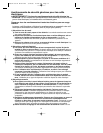
9
Operating Instructions
WARNING: To reduce the risk of serious personal injury,
read, understand and
follow all safety warnings and instructions prior to using tool.
WARNING: It is important to support the work properly and to hold the drill firmly
to prevent loss of control which could cause personal injury.
If you have any
questions on how to properly operate tool, call: 1-800-544-6986.
WARNING: Do not attempt to tighten drill bits (or any other accessory) by
gripping the front part of the chuck and turning the tool on.
Damage to the chuck
and personal injury may occur when changing accessories.
WARNING: To reduce the risk of injury,
always unplug drill from power supply before
making any adjustments or changing accessories.
WARNING: To reduce the risk of injury,
let the tool work at its own pace. Do not
overload.
Selecting the direction of rotation (DR250, DR320KG, DR330, DR650)
For drilling and for tightening screws, use forward (clockwise) rotation. For loosening
screws or removing a jammed drill bit, use reverse (counterclockwise) rotation.
Note: The direction of rotation is also depicted by an arrow on the drill housing.
WARNING: Never change the direction of rotation while the motor is running.
• To select forward rotation, push the forward/reverse slider (3) to the right (when viewed
from the chuck end).
• To select reverse rotation, push the forward/reverse slider (3) to the left (when viewed
from the chuck end).
Selecting the direction of rotation (DR550)
For drilling and for tightening screws, use forward (clockwise) rotation. For loosening
screws or removing a jammed drill bit, use reverse (counterclockwise) rotation.
WARNING:Never change the direction of rotation while the motor is running.
•Toselect forward rotation, push the forward/reverse slider (3) to the left (when viewed
from the chuck end).
• To select reverse rotation, push the forward/reverse slider (3) to the right (when viewed
from the chuck end).
Note: The direction of rotation is also depicted by an arrow on the drill housing.
WARNING: Never change the direction of rotation while the motor is running.
Selecting the drilling mode (DR650) (fig. F)
• For drilling in masonry, set the drilling mode selector (5) to the “hammer symbol” (18)
position.
• For drilling in other materials and for screwdriving, set the drilling mode selector (5) to the
“drill symbol” (19) position.
Two-gear selector (DR650) (fig. G)
• For drilling in steel and for screwdriving applications, turn the two-gear selector (4) into
position 1 by aligning the number with the mark on the housing (20) (1st gear). Also when
using larger diameter bits in wood turn the two gear selector into position 1.
• For drilling in materials other than steel and when using smaller diameter bits, turn the
two-gear selector (4) into position 2 by aligning the number with mark on the housing
(20) (2nd gear).
Setting the drilling depth (DR650)
• Slacken the side handle (9) by turning the grip counterclockwise.
• Set the depth stop (8) to the desired position. The maximum drilling depth is equal to the
distance between the tip of the drill bit and the front end of the depth stop.
• Tighten the side handle by turning the grip clockwise.
Screwdriving with clutch drill (DR330)
This tool is fitted with a collar to select the operating mode and to set the torque for
tightening screws. Large screws and hard workpiece materials require a higher torque
setting than small screws and soft workpiece materials.
• For drilling in wood, metal and plastics, set the collar to the drilling position symbol .
• For screwdriving, set the collar to the desired setting. If you do not yet know the
appropriate setting, proceed as follows:
638911-00 02 DR drills 3/20/08 10:20 AM Page 9


















